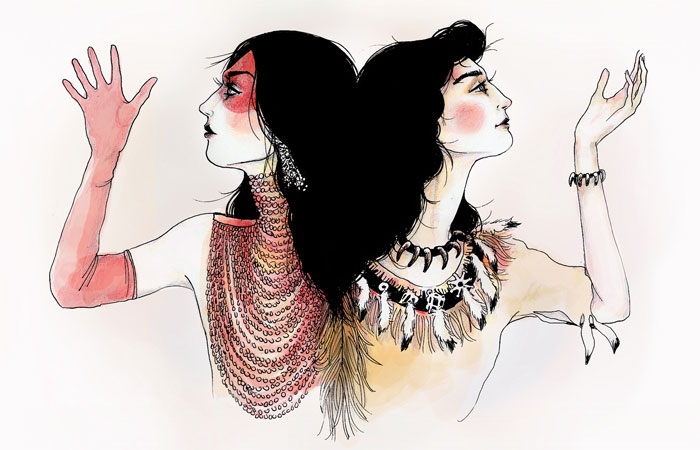Double VisionPosted in Articles, Biography, Canada, Literary/Artistic Criticism, Media Archive, Native Americans/First Nation, Women on 2012-10-12 04:38Z by Steven |
Emily Landau, Lecturer
Department of History
University of Maryland
Poet Pauline Johnson enthralled Victorian theatregoers with a stereotype-smashing spin on her Mohawk-English heritage. Along the way, she became Canada’s first postmodern celebrity
In late 1892, Emily Pauline Johnson, a prim thirty-one-year-old bluestocking, made her first appearances as her alter ego, Tekahionwake, decked out in a leather dress, moccasins, and all the other accoutrements a Victorian audience might expect a Native woman to wear. For the better part of the previous year, Johnson, a half-Mohawk, half-English poet, had been reciting her work in the salons of English Canada. She was building momentum in the world of letters for her romantic naturalist ballads, and was renowned for her beauty, her striking stage presence, and her impassioned recitals. She had developed a niche as one of Canada’s most accomplished New Women, a cohort of late nineteenth-century feminists who were shedding the sexist shackles of the era. But as her act gathered steam, she created the onstage persona of Tekahionwake, an exaggerated, heightened riff on existing stereotypes, but also an ambassador to familiarize theatregoers with the conditions suffered by Native women.
She ordered a buckskin costume from the Hudson’s Bay Company; ironically, she couldn’t find an authentic outfit on the Six Nations reserve outside of Brantford, Ontario, where she grew up. The dress came with moccasins and a beaded belt adorned with moose hair and porcupine quills. She tore off one sleeve and replaced it with rabbit pelts, then completed the outfit with a hunting knife. (She would later add a bear claw necklace, a wampum belt, and a Huron scalp that had belonged to her grandfather.) Johnson’s audiences ate it up, and she became one of the country’s first celebrities, her distinctive costume generating the same tittering, slightly scandalized, and utterly enthralled reactions as Madonna’s cone bra or Lady Gaga’s meat dress would provoke a hundred years later.
For the next seventeen years, Johnson toured the world as Tekahionwake. She was billed by her promoter, Frank Yeigh, as the Mohawk Princess (a marketing ploy she used throughout her career), and although her branding played into the stereotypes, her stories broke them down. Her tales and poems gave agency to First Nations women, hooking her audience with a mix of poise and campy histrionics. In a trademark flourish, she shed the buckskin during intermission and returned in a staid silk evening gown and pumps, eliciting gasps from spectators as they marvelled at the transformation. The two modes of dress served as an external manifestation of Johnson’s own dual identity: the name Tekahionwake, which she came to use in both her performances and her published poetry, means “double life” in Mohawk…
…With her curly brown hair, grey eyes, and light skin, Johnson could have passed as white, but throughout her life she insisted on asserting her Mohawk heritage. Her need to exaggerate her nativeness in her persona was a conscious act, but it was also likely born of the fact that Indigenous people were — and still are — the only racial group to be legally mandated in Canada. First Nations people had to prove their heritage by establishing that they were biologically descended from a member of an Indian band, which entitled them to certain rights and protections, but diminished their individual agency and relegated them to being glorified wards of the government. (Even the blood-determined “science” of status wasn’t fixed: a Native woman could lose those protections by marrying a non-Native.)…
Read the entire article here.
